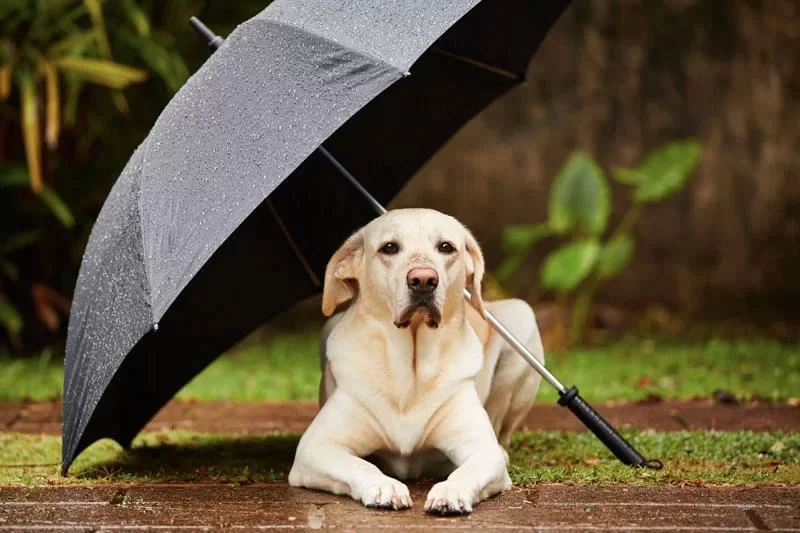How to Help Your Dog Overcome Fear of Thunderstorms
If you’ve ever seen your dog tremble, hide, or even try to escape during a thunderstorm, you know just how distressing it can be. I remember the first time my dog, Buddy, experienced a storm. He was a young, energetic puppy at the time, but when the first clap of thunder hit, his whole demeanor changed. His ears drooped, he began pacing around the house, and his usual joyful demeanor turned into full-blown panic. I couldn’t stand to see him so frightened, and I knew I had to do something about it. It turns out, Buddy's fear of thunderstorms wasn’t an isolated case. Many dogs suffer from this type of anxiety, and helping them manage their fear is essential for their well-being.
Why Do Dogs Fear Thunderstorms?
To understand how to help your dog overcome their fear of thunderstorms, it’s important to first understand why they feel this way. In Buddy's case, the loud noise and the flashing lightning created an overwhelming sensory overload. Dogs’ hearing is much more sensitive than ours, so the thunder sounds much louder to them than it does to us. Additionally, the flashing lights, combined with barometric pressure changes, can create an unsettling environment.
For many dogs, thunderstorms trigger a fear response due to the unpredictable nature of the storm. Dogs don’t understand what’s happening, and their instincts tell them to seek safety from what they perceive as a threat. This fear can be so intense that it causes them to show signs of anxiety, such as pacing, drooling, barking, or even attempting to escape to a safe spot, like a closet or under a bed. While Buddy wasn’t trying to escape, his nervous energy was unmistakable. After a few storms, I knew I had to intervene to help him manage his fear.
Signs of Thunderstorm Anxiety in Dogs
Before I could help Buddy, I needed to better understand the signs of his fear. I realized that every dog reacts differently during a storm, and some of the symptoms can be subtle. Here are some common signs of thunderstorm anxiety in dogs:
- Shaking or Trembling: This is one of the most common signs that your dog is scared. If your dog is visibly shaking during a storm, it’s likely they are experiencing anxiety.
- Pacing and Restlessness: Dogs who are anxious about storms often have a hard time sitting still. They may pace around the room, trying to find a way to escape or a place to hide.
- Excessive Barking or Whining: Some dogs vocalize their anxiety by barking or whining. Buddy, for instance, would whine non-stop when the storm began, unable to relax.
- Seeking Shelter: Dogs may look for a safe place to hide, such as under furniture or in small, enclosed spaces. Buddy would try to squeeze into the tightest spaces when he was feeling especially frightened.
- Drooling and Loss of Appetite: Increased drooling is another sign that a dog is stressed. Some dogs may also lose interest in food during a storm.
How to Help Your Dog During a Thunderstorm
Once I recognized that Buddy was scared, I began to research ways to help him cope with his anxiety during storms. I discovered several techniques that can be effective in calming dogs and helping them feel safer. Here are some methods I used to help Buddy, and I hope they’ll work for your dog too:
1. Create a Safe and Calm Environment
The first step in calming Buddy during a storm was to create a safe and quiet environment. I made sure to close all the windows and pull down the blinds to block out the flashing lights. Then, I put on soft music or white noise to help drown out the sounds of thunder. Many dogs find comfort in a cozy, enclosed space during storms, so I created a "safe room" where Buddy could retreat if he felt overwhelmed. I made sure it was a space he felt comfortable in, with his bed, favorite toys, and some treats.
2. Use Desensitization and Counter-Conditioning
Desensitization and counter-conditioning are training techniques that can help your dog gradually become less fearful of thunderstorms. I started playing a recording of thunder sounds at a very low volume while Buddy was doing something enjoyable, like playing with his toys or eating his favorite treat. Over time, I slowly increased the volume of the thunder sounds while continuing to reward Buddy for staying calm. This technique helped Buddy associate the sounds of thunderstorms with positive experiences, rather than fear. While this process took a few weeks, I could see that Buddy was less anxious with each storm that passed.
3. Try Anxiety-Relief Products
In addition to desensitization, I also turned to some anxiety-relief products to help Buddy feel more secure during storms. One of the most helpful products I used was a calming vest. These vests apply gentle pressure to your dog’s body, which has been shown to have a calming effect. The feeling is similar to swaddling a baby, and it can help ease anxiety. Buddy seemed to relax more quickly with the vest, especially when combined with a quiet, safe space.
Another product I used was a calming pheromone diffuser. These diffusers release synthetic versions of the calming pheromones that a mother dog would naturally release to comfort her puppies. The scent can help soothe your dog’s nerves during stressful situations like thunderstorms.
4. Provide Comfort and Reassurance
Sometimes, the best way to help your dog through a storm is simply by offering comfort and reassurance. Buddy would often seek me out during a storm, wanting to be near me for comfort. I would sit with him, pet him gently, and talk to him in a calm, soothing voice. While it’s important not to reward fearful behavior with treats or excessive attention, offering comfort during a storm can help your dog feel safe and secure. It’s a delicate balance, but showing your dog that you’re there for them can be a huge comfort.
5. Consult Your Veterinarian
If your dog’s fear of thunderstorms is severe and none of the above methods seem to help, it may be worth consulting with a veterinarian. In some cases, a vet might recommend anti-anxiety medication or behavioral therapy to help your dog manage their fear. Buddy’s anxiety was moderate, so I didn’t need to go this route, but for other dogs, professional help can make a world of difference.
Preventing Future Storm Anxiety
Once Buddy became more comfortable with thunderstorms, I continued to use the desensitization techniques during the off-season to ensure he stayed calm. The key to helping your dog overcome their fear of thunderstorms is consistency and patience. It can take time, but with the right methods, you can help your dog feel more secure during these stressful situations.
Watching Buddy grow more confident with each storm was incredibly rewarding. It reminded me that with the right approach, even the most fearful dogs can learn to cope with their anxieties. I hope that with these tips, you’ll be able to help your dog conquer their fear of thunderstorms too.












